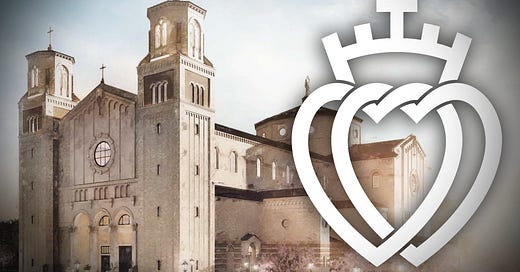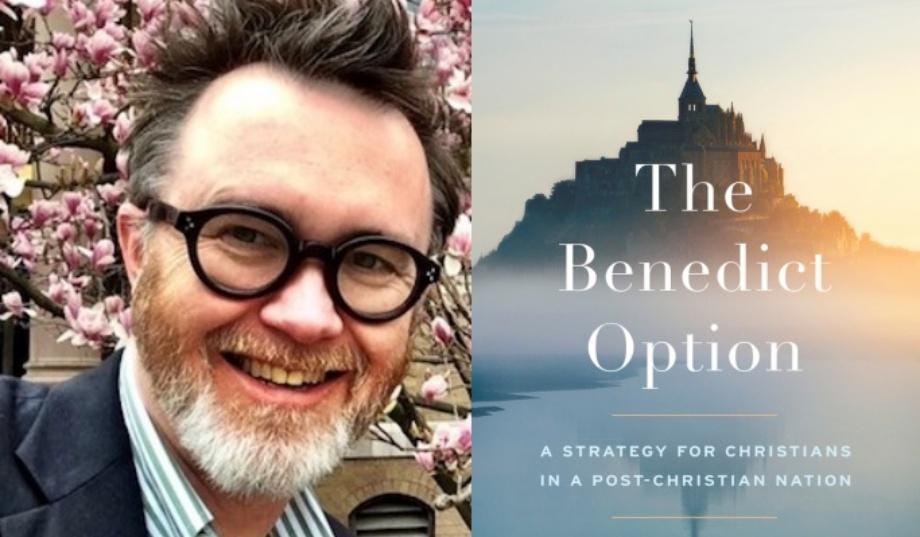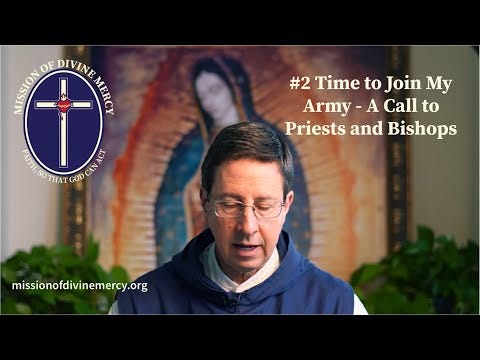Out of Time: Catholic Separatism in St. Marys, Kansas
An Essay from the Series "High Control Catholicism"
On the plains of Kansas, rising out of the wheat and wind, stands a vision of another age: a towering, 12-story tall traditionalist Catholic church that holds 1,550 people and is crowned by a 12 foot statue of Mary gilded in gold.
Inside, the air is thick with incense. The men arrive in suits and ties, while the women glide past in long skirts and lace mantillas, shepherding broods of children dressed in jumpers and starched collars. At the altar, the priest whispers the Latin prayers of a Mass that most American Catholics no longer recognize, his back turned to the congregation as a golden thurible sends sweet clouds of smoke curling toward the vaulted ceiling.
Everything here–the marble, the hymnals, the kneeling children–gleams with a sense of order, of solemn beauty, of eternal truth set apart from the chaos beyond. This is Catholicism as a spectacle of tradition, defiantly preserved against what the community members view as an encroaching modern, secular world.
At the traditionalist Catholic school in town, St. Mary’s Academy, there are knights carved into stone at the academy’s entrance, racks of toy soldiers in the church bookstore, and a crusading knight featured as logo and mascot. These symbols make up the visual language of this type of traditionalist Catholicism, and the messages about masculinity are clear: you must be a warrior for Christ.
In this town, filled with traditionalist Catholics who call this fortress of faith home, aesthetic and theology merge: heaven is hierarchical, eternal, and unchanging, and the faithful must build their own citadel on earth to reflect it.
And yet beneath the veneer of a romanticized “old faith” is something more complicated: a rejection of the modern church and a stubborn insistence that their way is the “right” way. As the bells toll across the fields and the faithful file into their pews, one wonders: is this a beacon of hope in a messy world, or a fortress of isolation where the faithful remain frozen in an imaginary past?
Note: this essay and case study about St. Marys, Kansas, is the second piece in our new High Control Catholicism series. Read the intro here. Our next essay will cover the Michigan group, Church Militant.
The Dangerous Appeal of High-Control Catholicism
Readers of The Atlantic may already be familiar with a little town called St. Marys, Kansas, thanks to Emma Green’s 2020 feature on it five years ago. In her piece, Green illustrates St. Marys as a kind of Catholic island, cut off from the wider world, where life revolves around the rigid–yet orderly–vision of faith promoted by the Society of Saint Pius X (SSPX). What she captured so well is how this community became a microcosm of a much bigger phenomenon: Christian groups, and especially certain Catholic ones, pulling away from the messiness of modern society and retreating into their own closed-off worlds. In this way, St. Marys also highlights how religious separatism can bleed into far-right politics, and even into fringe theologies like Sedevacantism, which outright rejects the authority of the pope.
That’s why we’re kicking off our high control series here–because it’s a good example that encapsulates a whole web of separatist and reactionary Catholic communities you may not even know exist.
What makes St. Marys–and places like it–noteworthy isn’t just that they’re “conservative” or “traditional” in a vague sense. These are communities that take those ideas to an extreme, reshaping not just how their members worship but how they live every single aspect of their lives. Schools, businesses, marriages, friendships–all of it happens inside the bubble. And while St. Marys is perhaps the most famous example, it’s not alone. Across the U.S., you can find charismatic Catholic groups, covenant communities, and other enclaves that follow similar patterns of isolation and control. To understand them, you have to understand the mindset: that the outside world is dangerous, even spiritually toxic, and the only way to stay faithful is to stay separate.
One term you’ll hear a lot when people talk about communities like St. Marys is the Benedict Option. The phrase comes from a 2017 book by journalist Rod Dreher, The Benedict Option: A Strategy for Christians in a Post-Christian Nation, where he argued that Christians should retreat from secular society and build isolated, intentional communities to preserve their faith. At the time, his proposal sparked fierce debate–and for good reason. While some praised it as a bold stand for traditional values, others pointed out how deeply un-Christian it is to wall ourselves off from our neighbors and the suffering of the world. After all, the gospel calls us to be salt and light within society, not to hide from it. Yet in 2025, you can see Dreher’s vision alive and well in places like St. Marys, and in countless smaller Catholic enclaves across the country–communities that mistake withdrawal for holiness and control for faithfulness.
The book’s title, of course, references St. Benedict of Nursia, a monk who lived as the Roman Empire collapsed. He responded to the chaos of his time by founding monastic communities that preserved Christian teachings through the so-called “dark ages.” For Dreher and those who embrace his ideas today, Benedict’s example becomes a kind of roadmap: when the culture around you feels hostile, you retreat, hunker down, and try to preserve what’s “pure” until the world comes around.
But that reading misses the heart of the gospel. St. Benedict’s monasticism wasn’t about self-righteous isolation–it was about prayer, service, and offering an alternative to violence and corruption, not simply hiding from the world. Dreher’s version, by contrast, recasts withdrawal as a moral duty. It’s easy to see why that promise of clarity, order, and control appeals to people when the world feels chaotic–but as we’ll explore in this series, that kind of isolation often harms both the people inside and the wider communities they turn their backs on.
Communities like St. Marys may offer safety and belonging to those who fit in, but they can also become high control environments where questioning isn’t welcome and individuality is suppressed. In fact, stories about the impact of the SSPX takeover of the town have already started to come out, including the forced removal of books about LGBTQ identities from the town library, the shutdown of a public swimming pool that was a source of town pride (due to swimsuit modesty concerns), as well as allegations of sexual abuse by SSPX priests. The LGBTQ books at the library issue in many ways reflects the latest US Supreme Court decision this past Pride Month allowing religious parents to opt out of lessons including LGBTQ+ stories.
Throughout this series, we’ll continue to feature different Catholic movements as case studies–from charismatic prayer groups to covenant communities to other traditionalist enclaves–and unpack the ways they attract people, hold on to them, and sometimes harm them. We’re starting in Kansas, but this isn’t just a story about one town. It’s about a much larger question: what happens when faith turns inward, and when the desire for purity and preservation ends up walling people off from the world–and sometimes, even from themselves?
How Vatican II Sparked an Identity Crisis for Catholic Traditionalists
At the heart of St. Marys SSPX vision of Catholicism isn’t just a love of tradition or a dislike of modern life. It’s a rejection of something much deeper: not only the authority of the pope, but also the sweeping changes brought about by one of the most significant events in modern Catholic history–the Second Vatican Council, or Vatican II. This single council set off shockwaves that are still being felt in Catholic communities around the world today–and it’s a moment we’ll keep coming back to throughout this series, because so many High Control Catholic movements in modern American Catholicism feature a negative response to this council.
So what exactly was Vatican II? Convened from 1962 to 1965, it was nothing less than a massive shift across many parts and aspects of the church–a global gathering of over 2,000 bishops, summoned by Pope John XXIII at a moment when both the world and the church stood at a crossroads. The scars of the Second World War were still raw, entire nations were grappling with decolonization, and movements for civil rights, women’s liberation, and social justice were challenging the old order. Within this upheaval, the Catholic Church was faltering–its ancient rituals and pronouncements felt increasingly out of step with the lives and hopes of ordinary people. John XXIII saw the danger clearly: the church risked irrelevance if it clung to a fortress mentality. But he also saw a way forward. What the church needed, he declared, was not to abandon its rich traditions, but to breathe new life into them–to throw open its windows to the modern world in a spirit of aggiornamento, or “bringing up to date.”
Across four sessions in Rome, over 2,000 bishops debated and voted on sixteen major documents that would reshape Catholic life. Among the most visible changes was the introduction of Mass in the vernacular–your own language–instead of the centuries-old Latin, thanks to the document Sacrosanctum Concilium. Other reforms opened the door for women to serve as lectors, Eucharistic ministers, and even altar servers in some dioceses, and removed the long-standing requirement that women cover their heads in church. These changes weren’t just cosmetic–they reflected a shift in how the church saw itself in relation to the world: less withdrawn and defensive, more engaged and accessible.
Vatican II also transformed the lives of those in religious life, especially nuns and sisters. For centuries, many had lived cloistered lives in habits and convents, but Vatican II encouraged them to take on more active roles in their communities, shed the strict dress codes, and move into apartments closer to the people they served. Many embraced this new freedom as empowering and energizing. But others felt adrift, left behind by changes they didn’t ask for and didn’t understand. Some left religious life altogether. Others gravitated toward communities and orders that were separatist and maintained a stricter, more traditional way of life–like the Dominican Sisters of St. Cecilia, where Sister Mary Jordan Hoover explained to NPR in 2012 that many young women sought “faithfulness to the church, respect for bishops, love of Mary.”
The tension between embracing change and clinging to what feels timeless has only grown more pronounced in the decades since Vatican II. Today you can see it reflected in the rising popularity of more conservative religious orders and among younger American priests who are extremely conservative and often prefer traditional liturgies. For radical traditionalist groups, Vatican II is seen not as a revitalization but as weakening the Church’s identity (“beige” Catholicism to use Bishop Barron’s term) and, in some cases, even invalidating the sacraments and the Mass itself.
Over and over, you’ll hear traditionalists frame their beliefs as a rejection to the “modernist” spirit of Vatican II. And that’s why this moment in history is so important to keep in mind: Vatican II didn’t just change the Church–it also features as an origin point of resistance that continues to shape high-control, separatist Catholic communities like St. Marys today.
The Society of St. Pius X
Life in St. Marys, Kansas revolves around the Society of Saint Pius X, or SSPX, which was founded in 1970 by Archbishop Marcel Lefebvre who dissented from the reforms of Vatican II. Even the namesake of the group, St. Pius X, was a staunch conservative known for vigorously opposing modernist interpretations of Catholic doctrine, and for promoting liturgical reforms and Thomist scholastic theology. The canonical status of the SSPX is extremely murky, but the lay faithful are devoted to their celebration of the Traditional Latin Mass (TLM).
Many in St. Marys aren’t just seeking to bring back pre-Vatican II liturgical traditions or customs like women veiling in mass or celebrating the TLM; they’re trying to recreate an entire pre-Vatican II world, or at least an imagined version of it. The SSPX’s approach to this vision isn’t to directly challenge Church leadership. Instead, they separate themselves–not just from secular American life, but often from the mainstream Church itself.
In 1988, Lefebvre and then-Cardinal Joseph Ratzinger (later Pope Benedict XVI) even drafted an agreement to secure SSPX’s canonical status–but it was never finalized. Today, SSPX leaders often frame their fight for Tridentine traditions as a fight for “freedom,” as one SSPX story from 2023 about Pope Francis put it. SSPX has managed to stay “on the fence” regarding their status within the institutional church, but that may not be the case forever.
Militant Mindset: The Spiritual Warfare of Traditionalism
The traditionalist impulse we see in St. Marys isn’t just about liturgy and dress–it’s also deeply tied to a worldview of spiritual warfare and apocalyptic urgency.
Another example of this dynamic outside of Kansas flared up in San Antonio, Texas, in early 2025 when Father John Mary Foster, founder of the Mission of Divine Mercy, published a series of so-called prophetic messages. Without approval from his archbishop, Foster claimed God had revealed to him that “the usurper” — meaning Pope Francis — was committing a “Great Treason” that would leave the Church desolate. When ordered to take down the messages, Foster instead doubled down, publishing a 17-page defense and questioning whether Catholics were obliged to obey a pope he believed was illegitimate. Within days, Archbishop Gustavo García-Siller stripped Foster of his ministry and dissolved the Mission’s apostolate status, citing confusion and false teaching.
Foster’s language of divine armies, soldiers of Christ, and resistance to Rome echoes a long history of traditionalist Catholic groups framing their mission as a kind of holy battle–not unlike the SSPX’s own fight to preserve pre-Vatican II practices. Groups like the Militia of the Immaculata, the Legion of Mary, and even the Quebec-based Army of Mary have all drawn on militaristic imagery to justify separation and control, often seeing themselves as a faithful remnant called to defend the “true” Church against corruption.
The Army of Mary, for example, was excommunicated in 2007 after its founder claimed to be the reincarnation of Mary herself–but not before training men for literal combat in what they saw as a spiritual war. Even more mainstream organizations, like the Knights of Columbus, borrow these same symbols, parading in military uniforms at parish pancake breakfasts, a reminder of just how deeply this rhetoric runs in traditionalist Catholic imagination.
In the end, whether it’s St. Marys in Kansas or a Marian militia in Quebec, the same thread runs through these movements: a longing to reclaim a version of Catholicism that feels pure, ordered, and unyielding–and a willingness to stand apart from the institutional church, and even against it, to achieve that vision.
The Nationalist Turn in Catholic Separatism
The growing calls to “dethrone” Pope Francis among traditionalist Catholics mirror the insurrectionist mindset we’ve seen take hold among far-right Christian nationalists in the United States. In both cases, the legitimacy of leadership is called into question, with claims that these leaders no longer represent the people they serve. Like their Protestant counterparts, Catholic nationalists blend religious conviction with political ideology, insisting that Francis’s leadership was not just harmful to the Church but a threat to the entire world. Some high control Catholics even eagerly await a Catholic monarchy in the US.
The merging of traditionalist Catholic separatism with far-right politics has only intensified in recent years. Some Catholics–what we might call semi-sedevacantists–stop short of outright declaring the papacy vacant but still framed Francis as dangerously illegitimate. Their rhetoric is often indistinguishable from that of nationalist movements calling for the removal of progressive leaders in both Rome and Washington.
The pattern was on display when the Spanish Poor Clares, a community of 16 sisters in Burgos and Vitoria, publicly broke from the Church. In a five-page open letter, their superior, Sister Isabel of the Trinity, accused the Vatican of spreading “contradiction, confusion, doublespeak, ambiguity,” echoing almost word-for-word the warnings of Father Foster in San Antonio. Like him, she backed up her claims with a lengthy manifesto, arguing that the post-Vatican II Church has forfeited its legitimacy.
How the Church will respond to these growing fractures remains to be seen–but the parallels to American politics are striking, and dangerous. Just days after Pope Francis called his conservative critics’ attitude “suicidal,” commentators were already tying the discontent in Rome to the discontent on the campaign trail in the United States. The same rhetoric appeared in Gary Hermesch’s letters to a Nebraska paper, calling to “Make the Church Great Again,” years before he shot and killed Father Arul Carasala. This convergence of militant traditionalism, nationalist politics, and violent rhetoric should give all of us pause–because what starts as nostalgia for a romanticized church can quickly curdle into something much darker.
Note: check out the first batch of reader submitted stories for the High Control Catholicism series. If you would like to share your story, leave a comment or send us a message on substack.
Conclusion
What’s happening in St. Marys is more than just a liturgical preference or a quaint attachment to old traditions. It’s part of a larger story about how faith, power, and politics intertwine–and how the changes set in motion by Vatican II continue to reverberate through the Catholic Church. Communities like St. Marys offer a kind of clarity and control that can feel comforting in a chaotic world, but that clarity often comes at the cost of separation, exclusion, and sometimes outright defiance of church authority. The militant imagination we see in groups like SSPX and even more extreme sedevacantists reflects not only nostalgia for a lost past but also a willingness to treat the church itself and the modern world as a literal battlefield with real violence.
The parallels to American political movements–particularly Christian nationalism–are hard to ignore. In both contexts, traditionalists reject leaders they see as illegitimate, embrace a vision of an imagined past, and are willing to break away or even turn violent to defend what they believe is under attack. And as we’ve seen, this isn’t limited to one small Kansas town. From San Antonio to Spain to Nebraska, these patterns keep playing out: groups declaring themselves the faithful remnant while accusing everyone else of betrayal.
But another thread running through the story of St. Marys is the story of a town “taken over.” Longtime residents have watched the community transform around them–schools, businesses, and civic life all reshaped by the influx of traditionalist Catholics. While some have spoken up, many seem resigned to the change. That response is telling. In other contexts–such as the events captured in the documentary Wild Wild Country, about indian guru Bhagwan Shree Rajneesh who brought all of his followers to a small town in Oregon–similar attempts at communal takeover by religious outsiders have been met with fierce resistance, especially when the newcomers don’t fit into white, Western assumptions about what’s normal or acceptable. The relative quiet around St. Marys takeover should make us wonder: whose separateness are we willing to tolerate, and whose do we fight?
In the end, St. Marys is a microcosm of something much bigger: a church still wrestling with its identity more than sixty years after Vatican II, and a country still deciding who belongs, who speaks for the people, and what it really means to follow the gospel of Jesus Christ.
Related: read about Max’s experiences at Franciscan University of Steubenville and with Opus Dei in the essay “True Crime in the Catholic Church.”













This is so exceptional, I don’t even know what to say. Incredible writing, incredible analysis. You are a treasure. This needs national exposure.
Thank you for this essay. Heartbreaking stuff, this high control movement and its distortion of Catholicism.